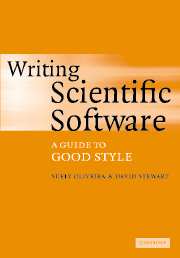Book contents
16 - Sources of scientific software
Published online by Cambridge University Press: 28 January 2010
Summary
The development of the Internet has contributed to the development of public libraries of scientific software. Some of this development has occurred through the efforts of individuals, through Internet collaborations (as with the development of Linux), and through government supported software development by academics and others (as with the development of LAPACK). There is a wide range of other software packages for scientific computing, many now written in C/C++, although Fortran and other languages are used for parts of many of these systems: PETSc (which supports the use of MPI for parallel computation), IML++ (an iterative methods library in C++), SparseLib++ (for handling sparse matrices in C++), and PLTMG (for solving partial differential equations).
In parallel with this, there has also been a tremendous development of commercial numerical software. Beginning in 1970 the Numerical Algorithms Group (NAG), based in the UK, developed libraries which have been sold commercially as the NAG libraries since 1976; the Harwell library was also developed in the UK; the IMSL libraries were developed commercially in the US. Another set of numerical libraries, called SLATEC, was developed by the Sandia and Los Alamos US National Laboratories and the US Air Force. These are available through netlib (see the next section). Perhaps the most spectacular example of commercial numerical software is the development of MATLAB. Initially a collection of Fortran 77 routines based on the early LINPACK and EISPACK libraries for dense matrix computations with a text interface, MATLAB has evolved into a full-featured interactive programming language with special support for numerical computation and scientific visualization.
- Type
- Chapter
- Information
- Writing Scientific SoftwareA Guide to Good Style, pp. 219 - 222Publisher: Cambridge University PressPrint publication year: 2006



